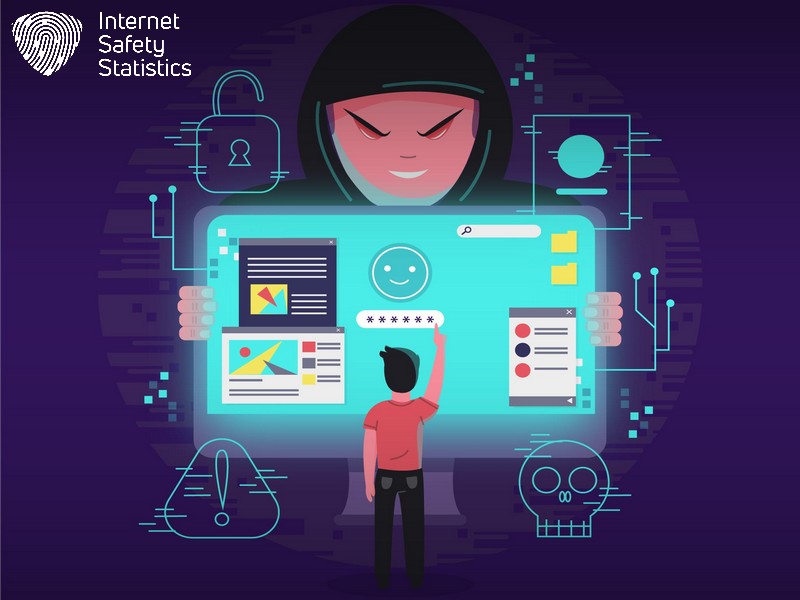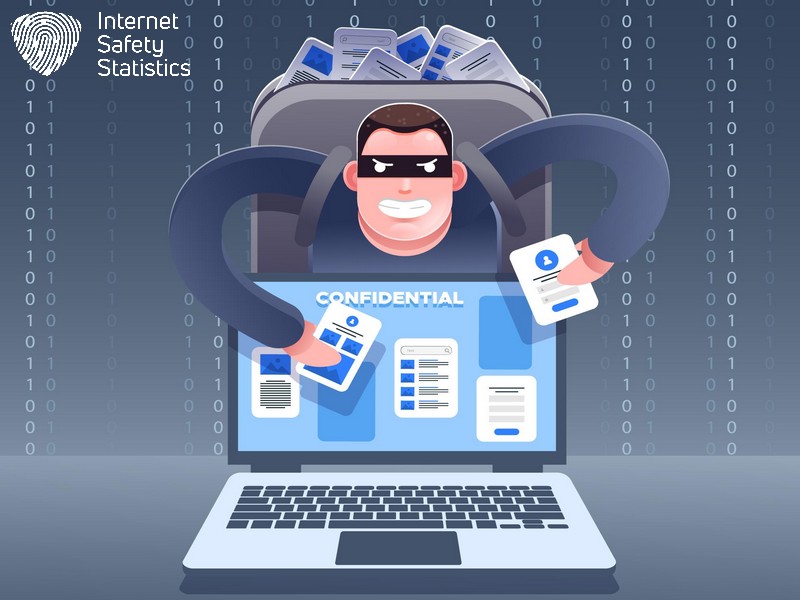
Cyber attacks are a modern-day threat affecting millions, from families to office workers. How do hackers operate? Each attack starts with cunning tactics that can breach even the most secure systems. The anatomy of a cyber attack aims to explain the tactics snoopers use to access your data and how they illegally use it online. This blog will unveil how these digital invasions unfold and arm you with the knowledge to safeguard your data.
So, stay alert; let’s explore their hidden world together.
The Components of a Cyber Attack
Cyber attacks have several stages, including reconnaissance, initial access, attack deployment, expansion, payment collection and cleanup. Understanding these components is crucial in protecting personal information and preventing financial loss or reputational damage.
Reconnaissance
In the initial phase of a cyber attack, hackers engage in reconnaissance to collect as much information about their target as possible. They meticulously study the target’s behaviours, defences, and vulnerabilities without alarming anyone that something malicious is on the horizon. Clever techniques like social engineering—tricking employees into revealing sensitive information—or conducting online research provide these attackers with valuable insights for crafting their attack strategies.
Hackers often scan systems for weak spots, such as outdated software or unprotected entry points. Gathering data during this stage can be alarmingly simple, especially if security measures aren’t up to date or if staff members are unaware of how precious their casual day-to-day info can be to prying eyes.
This silent watching and learning sets the foundation for more aggressive stages that follow, making it vital to have robust network security measures in place early on.
Initial Access
After conducting reconnaissance, cyber attackers move on to gaining initial access to a system. This is the crucial first step in their operation, where they exploit vulnerabilities or use social engineering tactics to infiltrate the target’s network. Once inside, hackers can quietly establish a foothold and begin their attack deployment without detection.
Hackers may utilise phishing emails, weak passwords, unpatched software, or vulnerable systems as entry points during this stage. Individuals and organisations need to focus on securing access points and regularly updating security measures to prevent unauthorised initial access by cybercriminals.
Attack Deployment
Cyber attackers deploy various methods to infiltrate systems and execute their malicious plans. Once they gain initial access, the attack deployment stage begins as hackers use sophisticated techniques to penetrate deeper into the network.
This can involve spreading malware, exploiting system vulnerabilities, or using social engineering tactics to manipulate employees into providing sensitive information. During this stage, hackers aim to establish a foothold within the targeted system, laying the groundwork for further exploitation.
Attack deployment is an intricate process that requires careful planning and execution by cybercriminals. They often employ multiple tactics simultaneously to maximise their chances of success and evade detection, making it essential for individuals and organisations to remain vigilant in safeguarding their digital assets against these threats.
Attack Expansion
Attack expansion is a critical stage in a cyber attack, where hackers move laterally within the network to gain access to more systems and sensitive data. At this point, they seek to broaden their control over the compromised infrastructure, potentially creating even greater damage.
Cyber attackers strategically expand their reach by leveraging stolen credentials or exploiting weaknesses in connected devices or unpatched software. This phase allows them to maintain persistence within the system and further pursue their malicious activities.
Hackers execute attack expansion precisely, aiming to remain undetected as they navigate the network. They can stealthily move from one device or server to another, often using sophisticated techniques that bypass traditional security measures.
Getting Paid
After attack expansion, cybercriminals proceed to the stage of “getting paid.” This is where hackers seek to monetise their illicit activities through ransom demands, selling stolen data on the dark web, or directly accessing financial accounts.
Cyber attackers are motivated by financial gain and may use extortion, fraud, or theft tactics to achieve their objectives. The profitability of cybercrime has led to increased sophisticated attacks and the emergence of organised cybercrime groups operating across borders.
As a target for these malicious activities, individuals and organisations must remain vigilant and implement robust security measures to protect sensitive information and assets from falling into the hands of cybercriminals.
Cleanup
Skilful hackers always cover their tracks as part of the clean-up process after successfully executing a cyber attack. This phase involves erasing evidence of their presence in the compromised system, removing traces of malware, repairing any vulnerabilities they exploited, and attempting to regain access if their initial point of entry has been closed off. Clean-up also includes covering up financial transactions and hiding data breaches to avoid detection by authorities or cybersecurity professionals.
Furthermore, during this stage, attackers may strategically manipulate log files and alter timestamps to create confusion about the timing and origin of the attack. Individuals and organisations must know that clean-up is not just about deleting files; it’s an intricate effort designed to leave no trace behind while ensuring continued access to future malicious activities.
The Importance of Understanding Cyber Attacks

Understanding cyber attacks is crucial for protecting personal information, preventing financial loss, and avoiding reputational damage. It empowers individuals and organisations to safeguard their digital assets and data security proactively.
Protecting Personal Information
Protect your personal information by regularly updating your privacy settings on social media and being cautious about the details you share online. Be mindful of phishing emails, and never click on suspicious links or provide personal information in response to unsolicited requests.
Use strong, unique passwords for each account and enable two-factor authentication where possible to add an extra layer of security. Regularly monitor your bank statements and credit reports for any unusual activity that could indicate a personal data breach.
Stay informed about the latest cyber threats and best practices for protecting your personal information to remain vigilant against potential cyber-attacks.
By taking proactive steps to safeguard your personal information, such as avoiding public Wi-Fi networks when accessing sensitive accounts, using secure payment methods online, and educating yourself about common hacker techniques like malware, you can reduce the risk of falling victim to a cyber attack.
Keep software up-to-date across all devices, as outdated software often presents vulnerabilities that hackers can exploit. Stay cautious when downloading apps or files from unknown sources, and be careful when sharing personal details over unsecured communication channels.
Preventing Financial Loss
To prevent financial loss from cyber attacks, it is important to be proactive in securing personal and financial information. Implementing strong password practices and regularly updating security software can help protect against data breaches and malware.
It’s also crucial to stay informed about the latest cyber threats and vulnerabilities, as well as to consider investing in comprehensive cybersecurity measures such as encryption and secure access points. By taking these precautions, individuals can significantly reduce their risk of falling victim to financially damaging cyber attacks.
Avoiding Reputational Damage
To avoid reputational damage, it is crucial to understand that a cyber attack compromises personal information, causes financial loss and tarnishes the reputation of businesses and individuals. Public trust in the affected entity can plummet once news breaks about a data breach or malware attack. In today’s digital age, where companies’ credibility is closely tied to their online presence, one successful cyber attack can have long-term consequences on an organisation’s brand image and customer loyalty.
Understanding this risk highlights the importance of robust cybersecurity measures to safeguard against potential reputational damage. Companies must proactively implement comprehensive security strategies to protect sensitive data and demonstrate their commitment to maintaining customer trust.
How Hackers Gather Information
Hackers gather information through social engineering, scanning for vulnerabilities, exploiting weaknesses, and utilising malware to access systems. To learn more about how hackers operate and how you can protect yourself, continue reading the full blog.
Social Engineering
Hackers employ social engineering to manipulate individuals into divulging confidential information or performing actions compromising security. They often use deceptive emails, phone calls, or messages to trick victims into revealing sensitive data like passwords or financial details.
By exploiting human psychology and trust, cybercriminals can gain unauthorised access to systems and perpetrate fraudulent activities. Understanding social engineering tactics is crucial for thwarting these malicious schemes and protecting personal and professional data from cyber threats.
Cyber attackers frequently exploit human vulnerabilities through social engineering techniques such as phishing, pretexting, baiting, and tailgating to infiltrate networks and extract valuable information for nefarious purposes.
Scanning for Vulnerabilities
Hackers search for weaknesses in computer systems and networks. They use specialised tools to scan for vulnerabilities that they can exploit. Once a vulnerability is identified, hackers can gain unauthorised access and steal sensitive information.
Regularly updating software and running security scans helps protect against these vulnerabilities. Failing to address vulnerabilities makes it easier for cyber attackers to breach systems and compromise data security. Being proactive about scanning for vulnerabilities is essential to stay ahead of potential threats.
Exploiting Weaknesses
Hackers exploit weaknesses in a system’s security to gain unauthorized access. Vulnerabilities such as unpatched software, default passwords, or weak network configurations are prime targets for cyber attackers. Once identified, these weaknesses are exploited through various means, often leading to breaches and data theft. Understanding and actively addressing these vulnerabilities is crucial in safeguarding personal information and preventing financial loss from cyber attacks.
Office workers must remain vigilant in identifying and rectifying potential weaknesses within their company’s systems to mitigate the risk of cyberattack exploitation. Deliberate steps should be taken to regularly update software, enforce strong password policies, and implement robust security measures to address known vulnerabilities effectively.
Utilising Malware
Hackers use malware to infiltrate computer systems and steal sensitive data, such as personal information and financial records. This malicious software can be disguised as legitimate applications or files, making it difficult for users to detect.
Once installed, the malware can operate quietly within a system, allowing hackers to access and exploit valuable data without raising suspicion. Individuals and organisations must implement robust cybersecurity measures to prevent malware infections and safeguard their digital assets from cyber threats.
Moving on from understanding how hackers utilise malware, let’s delve into the kill chain process of a cyber attack.
The Kill Chain Process

Once hackers gain initial access, they follow a systematic process known as the kill chain to exploit vulnerabilities further, escalate privileges, move laterally through networks, exfiltrate data and establish persistence. Understanding this process is crucial to prevent and mitigate cyber-attacks.
Delivery
Hackers use various methods to deliver their malicious payloads into a target network. They often employ phishing emails and social engineering tactics or exploit software vulnerabilities to gain initial access. Once inside the system, they may deploy malware and other tools to cause havoc. Understanding how these delivery methods work is essential for implementing effective security measures.
Protecting personal information and preventing financial loss requires staying one step ahead of cyber attackers. Cyber defence strategies such as employee training on recognising phishing attempts and regular security audits can help thwart delivery tactics used by hackers.
Exploitation
Hackers use various methods to exploit vulnerabilities and gain access to a system. They use software, hardware, and human behaviour weaknesses to infiltrate networks and steal sensitive information.
Exploitation involves using tactics like social engineering, scanning for vulnerabilities, exploiting weaknesses in security defences, and employing malware to compromise systems. Individuals and businesses must stay informed about the latest exploitation techniques hackers use to protect their data from cyber-attacks effectively.
Understanding how hackers exploit vulnerabilities is crucial for implementing robust cybersecurity measures to thwart potential attacks. By staying vigilant and continually updating security protocols, individuals can minimise the risk of falling victim to exploitation tactics employed by cybercriminals.
Privilege Escalation
Cyber attackers aim for privilege escalation, enabling them to access higher-level permissions within a system. By exploiting vulnerabilities, they elevate their privileges and gain control over critical files and resources. This allows them to move laterally through the network, accessing sensitive data and establishing persistent access points. Understanding how privilege escalation works is essential for implementing robust security measures to prevent cyber breaches.
Hackers exploit weaknesses in a system to escalate their privileges; this poses a significant threat as they can gain unfettered access to valuable information stored within networks or databases.
Lateral Movement
Cyber attackers use lateral movement to navigate a network after gaining initial access. This involves moving from one system to another, searching for valuable data and spreading their reach. Once inside a network, they explore different machines and systems, aiming to escalate their privilege levels and seize sensitive information or resources.
To achieve lateral movement, hackers exploit weaknesses in the network’s security protocols and gain control over multiple devices within the infrastructure. As they move laterally, they aim to remain undetected while seeking critical data or establishing persistent access for future activities.
Data Exfiltration
During data exfiltration, hackers stealthily steal sensitive information from a target system. Personal details, financial records, and confidential documents can be extracted without the victim’s knowledge. This process is often carried out in small increments to avoid detection. It’s essential for users and organisations to implement robust security measures and regularly monitor their systems to prevent illicit data exfiltration.
Moreover, understanding cyber attackers’ techniques during data exfiltration is crucial for safeguarding personal and sensitive information. Implementing encryption methods, restricting user access privileges, and employing advanced threat detection technologies are key strategies in protecting valuable data from falling into the wrong hands.
Establishing Persistence
To establish persistence, hackers aim to maintain access to the target system for as long as possible. They achieve this by embedding themselves deeply within the network so they can continue to extract sensitive data over an extended period. Once hackers successfully infiltrate a system, they work strategically to hide their presence and evade detection by altering log files or creating backdoor entries for future access.
Despite security measures being in place, hackers often use sophisticated methods that make it challenging for organisations to identify and remove them from the system. Therefore, understanding how attackers establish persistence is crucial in formulating effective defence strategies against cyber threats.
Prevention and Protection Strategies

Train employees, secure access points, implement Zero Trust Network Access (ZTNA), utilise machine learning, conduct regular security audits, and hire ethical hackers to protect against cyber attacks.
Train Employees
Educating employees about cyber threat prevention is crucial. Employees should be trained to recognise phishing emails and other social engineering tactics hackers use to access sensitive information. Regular training sessions on identifying potential cyber threats can help create a more vigilant workforce. By incorporating information security awareness into employee training, individuals become better equipped to safeguard personal data and prevent financial loss.
Empowering employees with the knowledge and skills to identify and report suspicious activities significantly strengthens the organisation’s cybersecurity posture. Building a culture of security awareness within the workplace enhances the overall resilience against cyber attacks, promoting a safer online environment for everyone.
Secure Access Points
To fortify your organisation’s cyber defences, securing access points within your network is crucial. This includes implementing robust authentication methods and encryption protocols to safeguard against unauthorised entry into sensitive data and systems.
Regularly updating passwords and utilising multi-factor authentication can add an extra layer of security, making it harder for hackers to gain illicit access. Furthermore, deploying intrusion detection systems and firewalls can help monitor and control the traffic entering and exiting the network, thereby preventing potential breaches.
In addition, restricting access privileges based on the principle of least privilege can minimise the risk of unauthorised activities within the network. Employing role-based access control ensures that only authorised individuals have specific permissions based on their organisational roles.
Implement Zero Trust Network Access (ZTNA)
Implementing Zero Trust Network Access (ZTNA) is essential to fortify your network security. ZTNA requires strict verification for any user or device attempting to access the network, regardless of location. This adds an extra layer of protection against unauthorised access and potential cyber threats. By utilising ZTNA, you can ensure that only authenticated and authorised users gain entry to your network, reducing the risk of a cyber attack.
Incorporating ZTNA into your network infrastructure enables you to enhance your defence mechanisms against potential cyber threats. It’s vital to stay informed about the latest cybersecurity practices to safeguard sensitive information from malicious intent.
Utilise Machine Learning
Implement machine learning to enhance your cybersecurity measures. Machine learning algorithms can analyse patterns in network traffic and user behaviour to identify potential threats before they escalate. By continuously learning from new data, these systems can adapt and evolve to stay ahead of cyber attackers constantly changing their tactics. This proactive approach is crucial in safeguarding personal information, preventing financial loss, and avoiding reputational damage.
Machine learning models can also detect anomalies in system activities that could indicate a security breach. Employing this technology alongside traditional security measures like firewalls and antivirus software provides a multi-layered defence against sophisticated cyber attacks. Stay vigilant and leverage machine learning to bolster your protection against evolving cyber threats.
Conduct Regular Security Audits
Regular security audits are essential in keeping your systems secure. They help identify vulnerabilities in your network and applications, ensuring that potential entry points for cyber attackers are identified and addressed promptly.
By conducting regular security audits, you can stay one step ahead of potential threats and protect sensitive information from falling into the wrong hands. These audits also ensure compliance with industry regulations and standards, giving you peace of mind that your data is protected.
To maintain a strong defence against cyber attacks, conducting regular security audits on all systems and networks is crucial. This proactive approach helps to identify weaknesses before they are exploited by hackers, ensuring that your organisation’s digital infrastructure remains resilient against evolving threats.
Hire Ethical Hackers
To enhance your organisation’s cybersecurity, consider hiring ethical hackers. These professionals, also known as white-hat hackers, use their expertise to identify and rectify vulnerabilities in your systems before malicious actors exploit them.
By simulating cyber attacks and uncovering weaknesses, ethical hackers help strengthen your defences against real threats. Their insights are invaluable in fortifying your network security and protecting valuable data from potential breaches.
Engaging ethical hackers can provide a proactive approach to safeguarding sensitive information. With their assistance, you can stay one step ahead of cyber threats by identifying and addressing vulnerabilities before malicious individuals or groups exploit them.
Understanding the anatomy of a cyber attack is crucial for protecting personal information, preventing financial loss, and avoiding reputational damage. Hackers operate stealthily and exploit vulnerabilities within a system using various tactics such as social engineering, malware utilisation, and privilege escalation.
Implementing prevention strategies like employee training, secure access points, and regular security audits is imperative to combat these evolving cyber threats effectively. Protecting against cyber attacks demands awareness and proactive measures from all internet users in today’s data-centric world.
FAQs
1. What is the anatomy of a cyber attack?
The anatomy of a cyber attack includes hackers’ steps to find weaknesses, gain unauthorised access and steal or damage data.
2. How do hackers identify vulnerabilities to exploit?
Hackers use various tools and techniques to scan systems for weak spots known as vulnerabilities, which they can then target in their attacks.
3. Can vulnerability management help prevent cyber attacks?
Yes, effective vulnerability management involves regularly checking and fixing security gaps to make it harder for hackers to succeed.
4. What happens once a hacker gains access through a cyber attack?
After gaining access, hackers might steal sensitive information, disrupt services or plant harmful software within systems.
